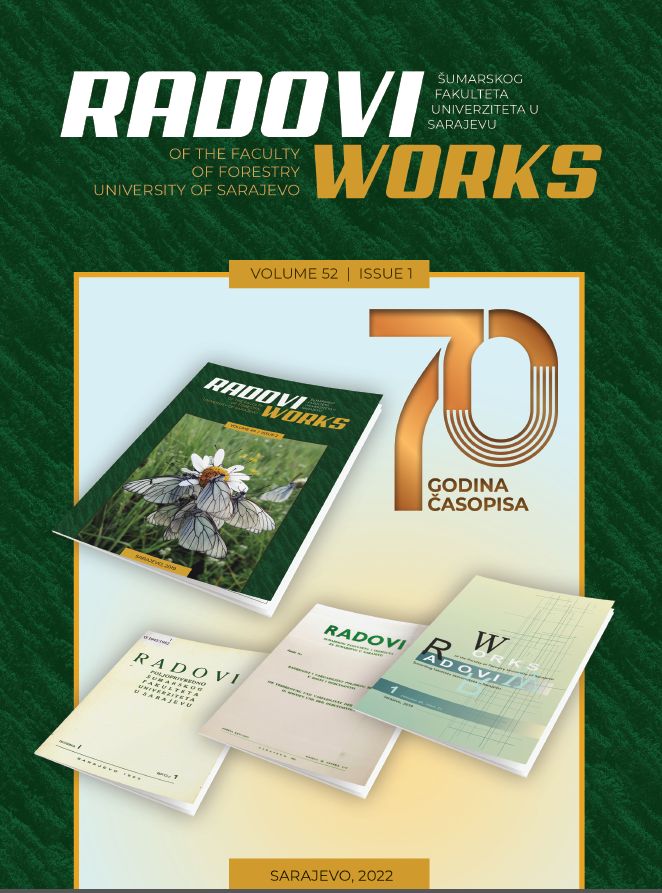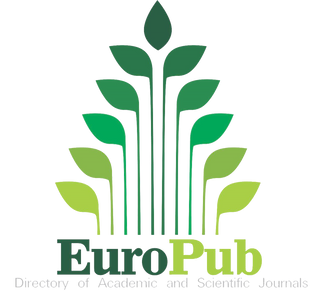Sadržaj ukupnih fenola, antioksidativna i antimikrobna aktivnost Silene sendtneri Boiss. (Caryophyllaceae)
DOI:
https://doi.org/10.54652/rsf.2022.v52.i1.367Sažetak
U ovoj studiji urađena je procjena ukupnog sadržaja fenola (TPC) i flavonoida (TFC) te antioksidativnog i an-timikrobnog djelovanja hidrometanolnih ekstrakata iz cvasti, stabljike, rizoma i sjemenki Silene sendtneri(Sendtnerova pušina, Caryophyllaceae). TPC, TFC i antioksidativna aktivnost (DPPH; 2,2-difenil-1-pikrilhidrazil) određeni su UV/VIS spektrofotometrijom. Antimikrobna aktivnost procijenjena je protiv odabranih testnih mikroorganizama (Staphylococcus epidermididis, Staphylococcus aureus subsp. aureus, Salmonella abony i Esche-richia coli, te Candida albicans) pomoću disk difuzijskog testa. Cvasti su imale najviši (11,587 mg GAEg-1 SM), a rizom najniži ukupni sadržaj fenola (TPC) (2,017 mg GAEg-1 SM). Najbogatiji sa ukupnim flavonoidima (TFC) bili su ekstrakti cvasti (69,824 mg CEg-1 DW), dok TFC nije detektovan u ekstraktu rizoma. Najveću antioksi-dativnu aktivnost (IC50; 20,51%) imao je ekstrakt stabljike, a najmanju rizoma (61,89%). Svi ekstrakti su poka-zali umjerenu antibakterijsku aktivnost samo protiv Staphylococcus epidermididis, te nisku aktivnost protiv tri preostala testirana organizma. Antifungalna aktivnost ekstrakata cvasti i rizoma bila je umjerena. Dobiveni re-zultati daju osnovu za daljnja istraživanja različitih ekstrakata S. sendtneri, koji mogu biti potencijalni prirodni antioksidanti i antimikrobni agensi.
Downloads
References
Ahmad, V.U., Ali, Z., Ali, M.S., & Zahid, M. (1998). Chemical constituents of Silene conoidea. Fitoterapia, 69(5), 406-408.
Alarcon, R., Ortiz, L.T., & Garcia, P. (2006). Nutrient and fatty acid composition of wild edible bladder campion populations [Silene vulgaris (Moench.) Garcke.]. International Journal of Food Science and Technology, 41, 1239-1242.
Aygun, R.B., Zengin, G., Yildiztugay, E., Jugreet, S., Yilmaz, M.A., & Mahomoodally, F.M. (2022). Chemical characterization, anti-oxidant and anti-enzymatic properties of extracts from two Silene species: A focus on different plant parts and extraction methods. Process Biochemistry, 116, 206-213.
Bajpai, V., Dung, N., Kwon, O., & Kang, S. (2008). Analysis and the potential applications of essential oil and leaf extracts of Silene armeria L. to control food spoilage and food-borne pathogens. European Food Research and Technology, 227, 1613-1620.
Bastola, K., Guragain, Y., Bhadriraju, V., & Vadlani, P. (2017). Evaluation of standards and interfering compounds in the determination of phenolics by folin-ciocalteu assay method for effective bioprocessing of biomass. American Journal of Analytical Chemistry, 8, 416-431.
Bauer, A.W., Kirby, W.M.M., Sherris, J.C., & Turck, M. (1966). Antibiotic susceptibility testing by a standardized single disk method. American Journal of Clinical Pathology, 36, 493-496.
Bennett, R.N., & Wallsgrove, R.M. (2006). Secondary metabolites in plant defence mechanisms. New Phytologist, 127, 617-633.
Cai, Y., Luo, Q., Sun, M., & Corke, H. (2004). Antioxidant activity and phenolic compounds of 112 traditional Chinese medicinal plants associated with anticancer. Life Sciences, 74, 2157-2184.
Conforti, F., Marrelli, M., Carmela, C., Menichini, F., Valentina, P., Uzunov, D., Statti, G.A., Duez, P., & Menichini, F. (2011). Bioactive phytonutrients (omega fatty acids, tocopherols, polyphenols), in vitro inhibition of nitric oxide production and free radical scavenging activity of non-cultivated Mediterranean vegetables. Food Chemistry, 129, 1413-1419.
Dixon, R.A., & Paiva, N.L. (1995). Stress-induced phenylpropanoid metabolism. Plant Cell, 7, 1085-1097.
Đug, S., Muratović, E., Drešković, N., Boškailo, A., & Dudević, S. (2013). Crvena lista flore Federacije Bosne i Hercegovine. EU “Greenway”, Sarajevo, p.p. 161.
Eggens, F. (2006). Systematics in Sileneae (Caryophyllaceae) - Taxonomy and phylogenetic patterns. Acta Universitatis Upsaliensis, Digital Comprehensive Summaries of Uppsala, Dissertations from the Faculty of Science and Technology, p.p. 251.
Ertürk, O., Kati, H., Yayli, N., & Demirbag, Z. (2006). Antimicrobial properties of Silene multifida (Adams) Rohrb. plant extracts. Turkish Journal of Biology, 30, 17-21.
Fabricant, D.S., & Farnsworth, N.R. (2001). The value of plants used in traditional medicine for drug discovery. Environmental Health Perspectives, 109, 69-72.
Filippidis, A., Papastergios, G., Kantiranis, N., Michailidis, K., Chatzikirkou, A., & Katirtzoglou, K. (2012). The species of Silene compacta Fischer as indicator of zinc, iron and copper mineralization. Chemie der Erde, 72, 71-76.
Golovko, V., & Bushneva, O. (2007). Stabilizing effect of Silene pectin polysaccharide on electrical activity of the sinoatrial area in frog heart. Bulletin of Experimental Biology and Medicine, 143, 284-286.
Grlić, Lj. (1990). Enciklopedija samoniklog jestivog bilja. August Cesarec, Zagreb. p.p. 117.
Hartmann Th. 2007. From waste products to ecochemicals: Fifty years research of plant secondary metabolism. Phytochemistry, 68, 2831-2846.
Hasanuzzaman, M., Bhuyan, M., Zulfiqar, F., Raza, A., Mohsin, S.M., Mahmud, J.A., Fujita, M., & Fotopoulos, V. (2020). Reactive oxygen species and antioxidant defense in plants under abiotic stress: Revisiting the crucial role of a universal defense regulator. Antioxidants (Basel, Switzerland), 9(8), 681.
Hossain, M.A., & Shah, M.D. (2015). A study on the total phenols content and antioxidant activity of essential oil and different solvent extracts of endemic plant Merremia borneensis. Arabian Journal of Chemistry, 8(1), 66-71.
Jakimiuk, K., Wink, M., & Tomczyk, M. (2022). Flavonoids of the Caryophyllaceae. Phytochemistry Reviews, 21, 179-218.
Kabera, J.N., Semana, E., Mussa, A.R., & He, X. (2014). Plant secondary metabolites: Biosynthesis, classification, function and pharmacological properties. Journal of Pharmacy and Pharmacology, 2, 377-392.
Kähkönen, M.P., Hopia, A.I., Vuorela, H.J., Rauha, J.P., Pihlaja, K., Kujala, T.S., & Heinonen, M. (1999). Antioxidant activity of plant extracts containing phenolic compounds. Journal of Agriculture and Food Chemistry, 47, 3954-3962.
Kandoudi, W., & Németh-Zámboriné, É. (2022). Stimulating secondary compound accumulation by elicitation: Is it a realistic tool in medicinal plants in vivo?. Phytochemistry Reviews. https://doi.org/10.1007/s11101-022-09822-3.
Karalija, E., Selović, A., Dahija, S., Demir, A., Samardžić, J., Vrobel, O., Ćavar Zeljković, S., & Parić, A. (2021). Use of seed priming to improve Cd accumulation and tolerance in Silene sendtneri, novel Cd hyper-accumulator. Ecotoxicology and Environmental Safety, 210, 111882.
Karamian, R., & Ghasemlou, F. (2013). Screening of total phenol and flavonoid content, antioxidant and antibacterial activities of the methanolic extracts of three Silene species from Iran. International Journal of Agriculture and Crop Sciences, 5, 305-312.
Kaur, S., & Mondal, P. (2014). Study of total phenolic and flavonoid content, antioxidant activity and antimicrobial properties of medicinal plants. Journal of Microbiology & Experimentation, 1(1), 00005.
Kliebenstein, J.D. (2013). Making new molecules – evolution of structures for novel metabolites in plants. Current Opinion in Plant Biology, 16, 112-117.
Kucukboyaci, N., Ozcelik, B., Adiguzel, N., & Goren, A. (2010). Fatty-acid compositions of Silene vulgaris and S. cserei subsp. aeoniopsis seeds and their antimicrobial activities. Chemistry of Natural Compounds, 46, 88-91.
Mamadalieva, N.Z., Zibareva, L.N., Lafont, R., Dainan, L., & Saatov, Z. (2004). Phytoecdysteroids from the Silene genus. Chemistry of Natural Compounds, 40(6), 574-578.
Mamadalieva, N.Z. (2012). Phytoecdysteroids from Silene plants: distribution, diversity and biological (antitumour, antibacterial and antioxidant) activities. Boletin Latinoamericano y del Caribe de Plantas Medicinales y Aromaticas, 11(6), 474-497.
Mamadalieva, N.Z., Egamberdieva, D., & Tiezzi, A. (2013). In vitro biological activities of the components from Silene wallichiana. Medicinal and Aromatic Plant Science and Biotechnology, 7, 1-6.
Mamadalieva, N.Z., Lafont, R., & Wink, M. (2014). Diversity of secondary metabolites in the genus Silene L. (Caryophyllaceae) – structures, distribution, and biological properties. Diversity, 6, 415-499.
Mamadalieva, N.Z., Ul’chenko, N.T., Yuldasheva, N.K., Zhanibekov, A.A., Egamberdieva, D.R., & Glushenkova, A.I. (2010a). Neutral lipids and biological activity of the CHCl3 extract of the aerial part of Silene guntensis. Chemistry of Natural Compounds, 46, 621-622.
Mamadalieva, N.Z., Ul’chenko, N.T., Yuldasheva, N.K., Egamberdieva, D.R., Zhanibekov, A.A., Dzhukharova, M.K., & Glushenkova, A.I. (2010b). Fatty-acid composition and antibacterial activity of CHCl3 extracts of three plants of the genus Silene. Chemistry of Natural Compounds, 46, 95-96.
Marhold, K. (2011). Silene sendtneri. Caryophyllaceae. – In Euro+MedPlantbase - the information resource for Euro-Mediterranean plant diversity [accessed 07.07.2022.].
Meda, A., Lamien, C.E., Romito, M., Millogo, J., & Nacoulma, O.G. (2005). Determination of the total phenolic, flavonoid and proline contents in Burkina Fasan Honey, as well as their radical scavenging activity. Food Chemistry, 91(3), 571-577.
Medda, S., Fadda, A., & Mulas, M. (2022). Influence of climate change on metabolism and biological characteristics in perennial woody fruit crops in the Mediterranean environment. Horticulturae, 8(4), 273.
Mihajilov-Krstev, T., Zlatković, B., Ilić, M., Stankov-Jovanović, V., & Mitić, V. (2015). Antimicrobial and antioxidant potential of wild growing Silene baccifera (L.) Roth. (Caryophyllaceae) fruits juice. Biologica Nyssana, 6(2), 55-58.
Mišić, LJ., & Lakušić, R. (1990). Livadske biljke. 1st ed. IP Svjetlost, Zavod za udžbenike i nastavna sredstva, Sarajevo – Zavod za udžbenike i nastavna sredstva, Beograd. p.p. 24.
Morrisey, J.P., & Osbourn, A. (1999). Fungal resistance to plant antibiotics as a mechanism of pathogenesis. Microbiology and Molecular Biology Reviews, 63, 708-724.
Mouffouk, C., Mouffouk, S., Dekkiche, S., Hambaba, L., & Mouffouk, S. (2019). Antioxidant and antibacterial activities of the species Silene inflata Sm. PSM Biological Research [Internet], 4(2), 74-86.
Nadgórska-Socha, A., Kandziora-Ciupa, M., Ciepal, R., & Walasek, K. (2011). Effects of Zn, Cd, Pb on physiological response of Silene vulgaris plants from selected populations. Polish Journal of Environmental Studies, 20(3), 599-604.
Ordoñez, A., Gomez, J., Vattuone, M., & Isla, M. (2006). Antioxidant activities of Sechium edule (Jacq.) Swart extracts. Food Chemistry, 97, 452-458.
Oreopoulou, V. (2003). Extraction of natural antioxidants. In Tzia, C., Liadakis, G. (Ed.), Extraction optimization in food engineering, Marcel Dekker, New York.
Ribera, A., & Zúñiga, G.E. (2012). Induced plant secondary metabolites for phytopatogenic fungi control: a review. Journal of Soil Science and Plant Nutrition, 12(4), 893-911.
Royal Botanic Gardens, Kew, https://powo.science.kew.org/taxon/urn:lsid:ipni.org:names:331962-2, (30/06/2022).
Santos-Sánchez, N.F., Salas-Coronado, R., Villanueva-Cañongo, C., & Hernández-Carlos, B. (2019). Antioxidant compounds and their antioxidant mechanism. In Shalaby, E., (Ed.), Antioxidants [Internet]. London: IntechOpen, https://www.intechopen.com/chapters/66259, (06/07/2022).
Selitrennikoff, C.P. (2001). Antifungal proteins. Applied and Environmental Microbiology, 67, 2883-2894.
Shahidi, F., Janitha, P.K., & Wanasundara, P.D. (1992). Phenolic antioxidants. Critical Reviews in Food Science and Nutrition, 32(1), 67-103.
Sharma, A., Shahzad, B., Rehman, A., Bhardwaj, R., Landi, M., & Zheng, B. (2019). Response of phenylpropanoid pathway and the role of polyphenols in plants under abiotic stress. Molecules, 24(13), 2452.
Šilić, Č. (1988). Endemične biljke. 2nd ed, IP „Svjetlost“; Zavod za udžbenike i nastavna sredstva, Sarajevo; Zavod za udžbenike i nastavna sredstva, Beograd. p.p. 31.
Singelton, V.L., Orthofer, R., & Lamuela-Raventos, R.M. (1999). Analysis of total phenols and other oxidation substrates and antioxidants by means of Folin-Ciocalteu reagent. Methods in Enzymology, 299, 152-178.
Spiridon, I., Bodirlau, R., & Teaca, C.-A. (2011). Total phenolic content and antioxidant activity of plants used in traditional Romanian herbal medicine. Central European Journal of Biology, 6(3), 388-396.
Taskin, T., & Bitis, L. (2013). Antioxidant activity of Silene alba subsp. divaricata and Stellaria media subsp. media from Caryophyllaceae. Spatula DD, 3(1), 1-5.
Verpoorte, R. (2000). Pharmacognosy in the new millenium: leadfinding and biotechnology. Journal of Pharmacy and Pharmacology, 52, 253-262.
Webster, D., Taschereau, P., Belland, R.J., Sand, C., & Rennie, R.P. (2008). Antifungal activity of medicinal plant extracts. Preliminary screening studies. Journal of Ethnopharmacology, 115, 140-146.
Wink, M. (2008). Plant secondary metabolism: Diversity, function and its evolution. Natural Product Communications, 3(8), 1205-1216.
Wolfe, K., Wu, X., & Liu, H.R. (2003). Antioxidant activity of apple peels. Journal of Agricultural and Food Chemistry, 51, 609-614.
Zheng, W., & Wang, S.Y. 2001. Antioxidant activity and phenolic compounds in selected herbs. Journal of Agriculture and Food Chemistry, 49, 5165-5170.
Downloads
Objavljeno
How to Cite
Broj časopisa
Rubrika
License
Copyright (c) 2022 Fatima Pustahija, Sabina Rastoder, Rasim Duraković Duraković, Mirel Subašić, Neđad Bašić, Adisa Parić

This work is licensed under a Creative Commons Attribution 4.0 International License.






















